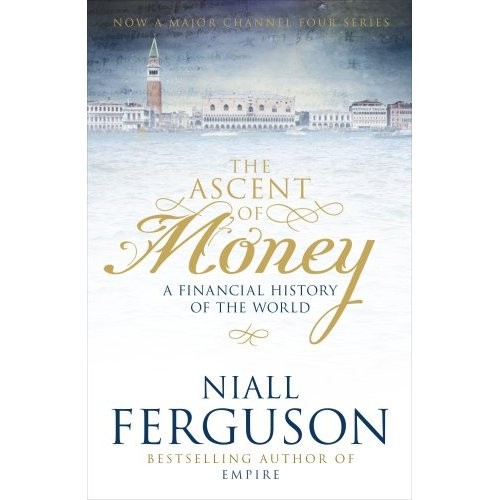The ascent of money A financial history of the world
Post on: 30 Июль, 2015 No Comment

Add this article to your reading list by clicking this button
THE typical career of a Wall Street banker lasts about a quarter of a century, enough to span just one big financial crisis. As Niall Ferguson explains in his new book, “The Ascent of Money”, which will be published next month, todays senior financiers would have started out in 1983, fully ten years after oil and gold prices first began the surge that had ruined the previous generation of money men. That, he concludes, is a “powerful justification for the study of financial history.”
Mr Ferguson is right. The world needs a book that puts todays crisis into context. It is too late now to warn investors about expensive houses and financiers about cheap credit. But perhaps the past can help make sense of the wreckage of banks, brokers and hedge funds that litters the markets. Looking back may help suggest what to do next. And when the crisis is over and it is time for the great reckoning, the lessons of history should inform the arguments about what must change.
This rushed, uneven book, by a British-born Harvard University professor who made his name a decade ago with a history of the Rothschild banking dynasty, will contribute less than expected to that debate. It has strengths, including a tidy account of the run-up in housing markets and of the symbiotic rivalry between America and China. But in the earlier chapters—the history, oddly enough, where you would expect Mr Fergusons ambitions for his subject to quicken his judgments—the words rarely come to life, either as a source of ideas or as narrative.
In this section
Perhaps the book was bound to be flawed, given the pace with which todays crisis has torn through the markets. As the debacle has unfolded, from a housing crisis, to a credit bust, a bank run and what now looks ominously like a global recession, each episode has posed different questions. Finishing his manuscript in May this year, Mr Ferguson must have been dizzy with the unravelling of certainties. And yet, he is at his strongest in his reading of the news. His story of what is happening today shows prescience, even if it is necessarily incomplete.
It may be that Mr Ferguson was too distracted by the present to pay enough attention to the past. Claiming to be “A Financial History of the World”, the book dutifully dabbles in societies, such as the Inca, who did not see gold and silver as money, and in the pre-Christian Mesopotamian clay tablets that served as credit notes for commodities. He traces the transformation of banchieri. named for the benches where money was changed, into the families that dominated the political and cultural life of Renaissance Italy and from there into modern bankers. He explains how the bond market had its origins in the states need for money to finance war. He describes how manias have repeatedly engulfed greedy investors over the centuries—concentrating on John Law, whose schemes ruined 18th-century France. And he rehearses the story of financial risk from its origins in Enlightenment Scotland.
Yet the reader is left wondering quite who the book is aimed at. The finance specialist will not find enough here to begin to compete with the work of Charles Kindleberger, an economic historian. And the reader who wants to know how finance is interwoven with general history would do better to turn to Jeffry Friedens excellent 2006 work, “Global Capitalism”.
Mr Ferguson may seem to be speaking to a general audience, given that he has taken his title from “The Ascent of Man”, Jacob Bronowksis book and television series of a quarter-century ago which analysed the contribution of science to civilisation. Yet these readers will be baffled by passages that breezily toss around ideas like “sterilisation”—the issue of bonds by a government to mop up the inflation-inducing money it prints to buy foreign currency. And they may be put off by Mr Fergusons attempt to be jolly. After two and half pages on the mathematics of bond yields, for example, comes this quip: “So how did this ‘Mr Bond become so much more powerful than the Mr Bond created by Ian Fleming? Why, indeed, do both kinds of bond have a licence to kill?”
Of far greater interest is Mr Fergusons general theory, which does not emerge until the end of the book. He thinks that finance evolves through natural selection. Although the professor cautions against the sort of Darwinism that sees evolution as progress, he believes that new sorts of finance are constantly coming into being as the environment changes. The sequence of creation, selection and destruction is what has generated many of the financial techniques that modern economies depend on.
This leads Mr Ferguson to make two timely points. One is to remember that evolution depends on extinction as well as creation. You have to allow ill-adapted techniques to fail if you are going to get something new. As the world rushes around rescuing every bank in sight, it is a reminder that the guarantor-state will later have to administer painful medicine.
The other is to observe the wonder of what financial evolution has created. Just now it is only natural to think of the “roller-coaster ride of ups and downs, bubbles and busts, manias and panics, shocks and crashes.” But Mr Ferguson sees something else too: “From ancient Mesopotamia to present-day China…the ascent of money has been one of the driving forces behind human progress: a complex process of innovation, intermediation and integration that has been as vital as the advance of science or the spread of law in mankinds escape from the drudgery of subsistence agriculture and the misery of the Malthusian trap.” Amid this financial bust, cleave to that.














